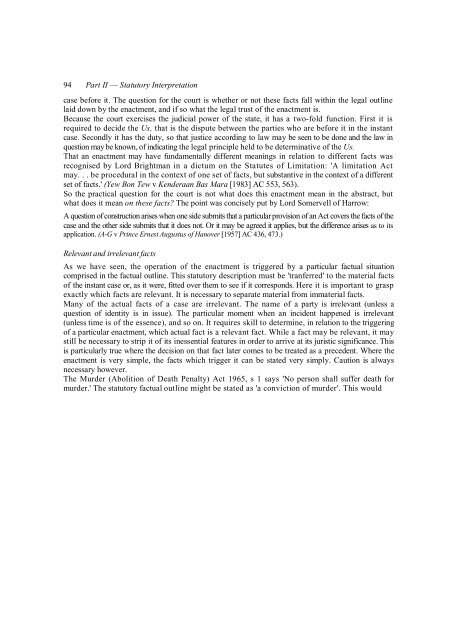Statutory Interpretation The Technique of Statutory ... - Francis Bennion
Statutory Interpretation The Technique of Statutory ... - Francis Bennion
Statutory Interpretation The Technique of Statutory ... - Francis Bennion
Create successful ePaper yourself
Turn your PDF publications into a flip-book with our unique Google optimized e-Paper software.
94 Part II — <strong>Statutory</strong> <strong>Interpretation</strong><br />
case before it. <strong>The</strong> question for the court is whether or not these facts fall within the legal outline<br />
laid down by the enactment, and if so what the legal trust <strong>of</strong> the enactment is.<br />
Because the court exercises the judicial power <strong>of</strong> the state, it has a two-fold function. First it is<br />
required to decide the Us, that is the dispute between the parties who are before it in the instant<br />
case. Secondly it has the duty, so that justice according to law may be seen to be done and the law in<br />
question may be known, <strong>of</strong> indicating the legal principle held to be determinative <strong>of</strong> the Us.<br />
That an enactment may have fundamentally different meanings in relation to different facts was<br />
recognised by Lord Brightman in a dictum on the Statutes <strong>of</strong> Limitation: 'A limitation Act<br />
may. . . be procedural in the context <strong>of</strong> one set <strong>of</strong> facts, but substantive in the context <strong>of</strong> a different<br />
set <strong>of</strong> facts.' (Yew Bon Tew v Kenderaan Bas Mara [1983] AC 553, 563).<br />
So the practical question for the court is not what does this enactment mean in the abstract, but<br />
what does it mean on these facts? <strong>The</strong> point was concisely put by Lord Somervell <strong>of</strong> Harrow:<br />
A question <strong>of</strong> construction arises when one side submits that a particular provision <strong>of</strong> an Act covers the facts <strong>of</strong> the<br />
case and the other side submits that it does not. Or it may be agreed it applies, but the difference arises as to its<br />
application. (A-G v Prince Ernest Augustus <strong>of</strong> Hanover [1957] AC 436, 473.)<br />
Relevant and irrelevant facts<br />
As we have seen, the operation <strong>of</strong> the enactment is triggered by a particular factual situation<br />
comprised in the factual outline. This statutory description must be 'tranferred' to the material facts<br />
<strong>of</strong> the instant case or, as it were, fitted over them to see if it corresponds. Here it is important to grasp<br />
exactly which facts are relevant. It is necessary to separate material from immaterial facts.<br />
Many <strong>of</strong> the actual facts <strong>of</strong> a case are irrelevant. <strong>The</strong> name <strong>of</strong> a party is irrelevant (unless a<br />
question <strong>of</strong> identity is in issue). <strong>The</strong> particular moment when an incident happened is irrelevant<br />
(unless time is <strong>of</strong> the essence), and so on. It requires skill to determine, in relation to the triggering<br />
<strong>of</strong> a particular enactment, which actual fact is a relevant fact. While a fact may be relevant, it may<br />
still be necessary to strip it <strong>of</strong> its inessential features in order to arrive at its juristic significance. This<br />
is particularly true where the decision on that fact later comes to be treated as a precedent. Where the<br />
enactment is very simple, the facts which trigger it can be stated very simply. Caution is always<br />
necessary however.<br />
<strong>The</strong> Murder (Abolition <strong>of</strong> Death Penalty) Act 1965, s 1 says 'No person shall suffer death for<br />
murder.' <strong>The</strong> statutory factual outline might be stated as 'a conviction <strong>of</strong> murder'. This would

















